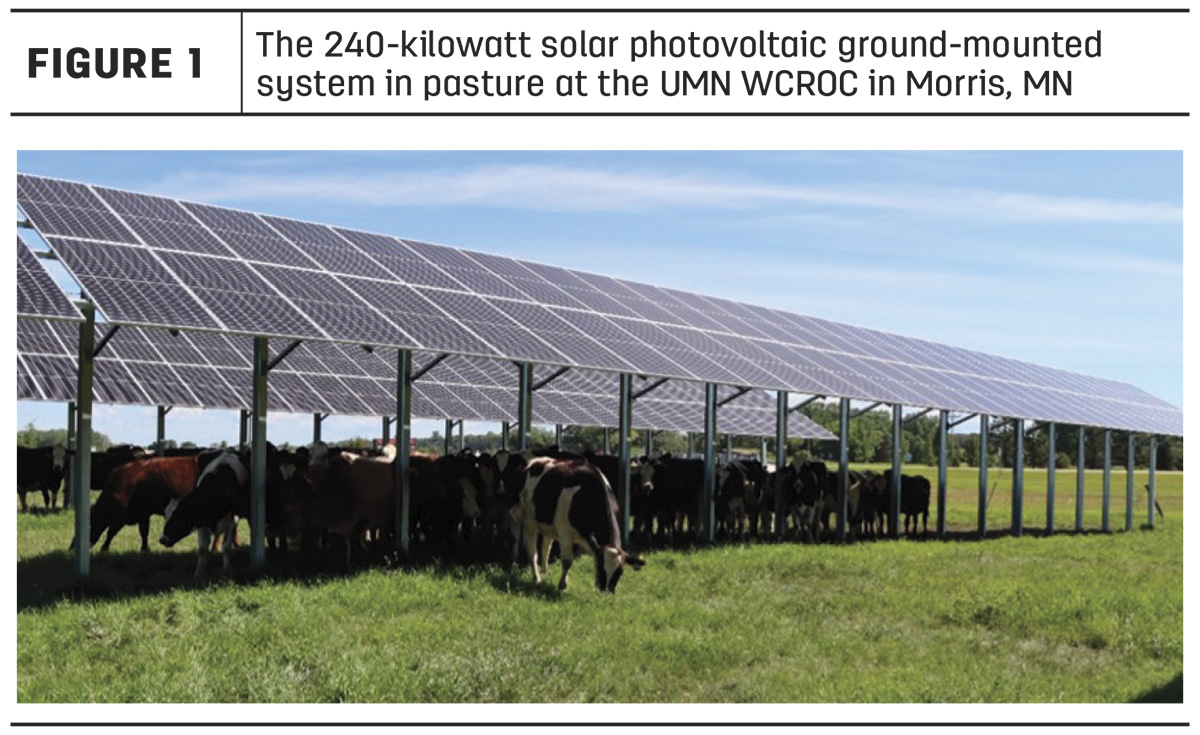The dairy industry consumes an immense amount of fossil fuels in the production of food, feed, fiber and energy. The agricultural industry is captive to large and constant supplies of a wide range of fossil energy used to cool milk on the farm, fuel combines and tractors, bring goods to market, and fertilize plants.
Dairy farmers have long been reducing the environmental impact of dairy farming and responsibly managing their land, air and water resources. Using an agrivoltaics system in a pasture, which is the integration of solar photovoltaics and agriculture, could boost land efficiency by up to 75%. Potential on-site renewable electric generation could also supply some or the entire electric load, allowing dairy farms to approach net zero. Agrivoltaics is one way producers might be able to become less dependent on fossil fuels, lower production costs, increase land efficiency, improve forages and crops for use by dairy cattle, and increase milk production and health in dairy cows.
“Can you graze cattle under solar panels?” is a question we always hear. The answer is, "Yes." Using a ground-mounted PV system in a dairy grazing herd could provide shade to dairy cows during extreme heat events and provide farmers with an alternative means of income.
The general concept of the research program at the University of Minnesota West Central Research and Outreach Center (WCROC) in Morris, Minnesota, is to evaluate solar PV for multiple uses in a grazing-based dairy. In addition to generating electricity, the panels will be evaluated for use as livestock shade to improve animal comfort and productivity. The solar-generated electricity will be utilized for a fast-charging station, and electric all-terrain utility vehicles will be charged by solar energy and used within the pasture and dairy farm. This study is the first step to convert fossil-based vehicles used in dairy farms to clean and locally-produced energy.
There was no research that had investigated the use of a ground-mounted solar system to provide shade for dairy cows and to determine the effects on dairy cows. Therefore, our team wanted to investigate the effects of shade from solar photovoltaic panels on the production, health and behavior of pastured dairy cows. During the summer of 2018, a 30-kilowatt ground-mounted solar system was installed in a pasture at the WCROC. The panels were mounted at 35º south and 2.4 to 3 meters from the ground so that cows could not reach the panels. The cost increase for mounting the panels above the cows was minimal and the total cost was about $90,000. In 2020, a 240-kilowatt ground-mount solar array was added to the existing pasture for shade for grazing dairy cattle (Figure 1). The Morris dairy operation milks 275 cows twice daily and is representative of a mid-size Minnesota dairy farm.

The pastured dairy cow study was conducted during the summer of 2019. Twenty-four crossbred cows were assigned to one of two treatments: shade from solar PV or no shade. The no-shade cows did not have access to any shade on pasture. All cows had a CowManager eartag sensor to record ruminating, eating, inactive and active behaviors for all cows. Also, a smaXtec bolus was placed in the reticulum of the cows to record internal body temperature as well as activity and drinking bouts. Daytime ambient high temperatures during the study ranged from 81-93ºF.
The shade and no-shade cows were similar for behavioral measurements and fly numbers on cows. The shade cows had less overall high activity than did no-shade cows because they were standing underneath the solar panels during the hot hours of the day. Daily drinking bouts were similar for all cows. Respiration rates for shade and no-shade cows were similar during the morning hours, but during the afternoon, shade cows had lower respiration rates (66 breaths per minute) than no-shade cows (78 breaths per minute). Milk, fat and protein production were not different for cows whether they had shade or no shade. Quite possibly, no difference was observed for production because cows were only under the shade for 28 of the 175 grazing days during the summer. Long-term effects of milk production may have been observed had cows been under the shade for the entire summer.
Hourly body temperature results show that no-shade cows had greater internal body temperatures (+1℉) than shade cows from 1:00 p.m. to midnight. Between milking times (10:00 a.m. to 8:00 p.m.), the shade cows had lower internal body temperatures than no-shade cows. All cows had similar body temperatures during the nighttime hours.
Hourly activity, eating, rumination and inactivity across a 24-hour period from the eartags were similar for shade and no-shade cows. However, the shade cows had lower high activity (6.7 minutes per hour) than did no-shade cows (7.8 minutes per hour). This could be due to bunching behavior that cattle exhibit, which is thought to reduce radiant heat absorption as cattle provide shade for each other. Shade cows may have had less bunching because the area under the shade was large and allowed cows to spread out under the solar panels.
Based on the results of this study, cows may have sacrificed grazing time to stand in the protection of the shade. Future research with our solar panels will investigate the reproductive performance of the cows and long-term effects on milk, fat and protein production; bodyweight, body condition, and animal health and well-being. Our study indicates that agrivoltaics may provide an acceptable method of heat abatement to pastured dairy cows, as well as generating electrical energy for farmers, thus reducing the carbon footprint of the dairy operation.
A new agrivoltaics project was started in 2021 at our grazing dairy. The project will provide new frameworks that will develop and model innovative structural designs for a combination solar shade for pastured livestock during the summer and windbreaks/snow fences for cattle during winter. We will also evaluate the potential for solar arrays to produce electricity and serve as field windbreaks on lands that are marginal for livestock production. We will model and test novel use of tracking systems to optimize solar energy potential. The project, funded by the Minnesota Environment and Natural Resources Trust Fund, will involve testing these new strategies to assess results and make recommendations to farmers. Economic impacts of the agrivoltaics system and land productivity from solar farms will drive the adoption of solar photovoltaic systems on farms.





